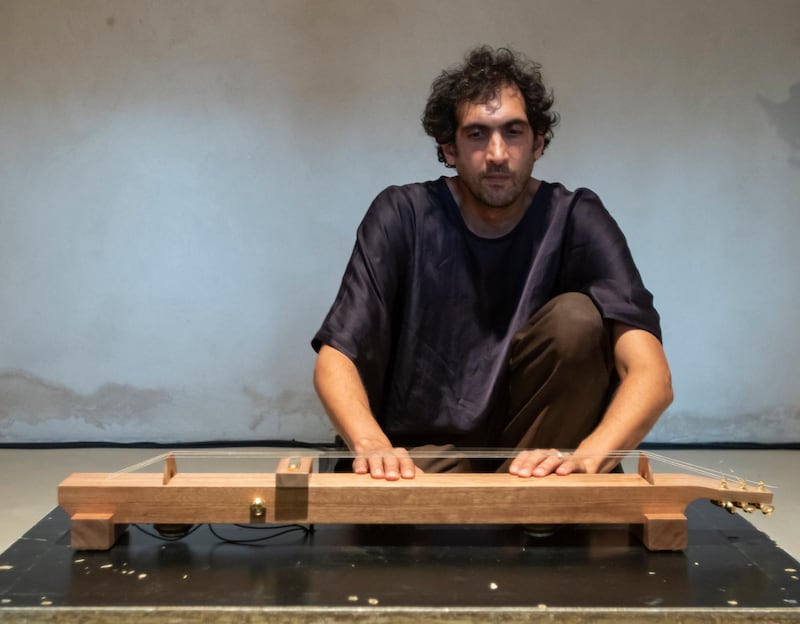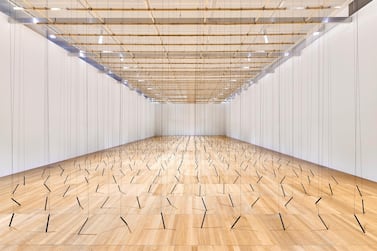Hunched over a waist-high table with a drum skin stretched across its centre, Tarek Atoui lets marbles drop from his cupped hands. As they roll on the taut plastic, the Lebanese artist begins pulling at a thin strip of film running through the middle of the drum skin, causing it to shake and the marbles to bounce.
The resulting sound is like the patter of raindrops on a tin roof. It envelops the room in Bait Al Serkal at the Sharjah Art Foundation.
Atoui’s pop-up performance at the venue on Saturday, September 19, marked the launch of his exhibition, Cycles in 11.
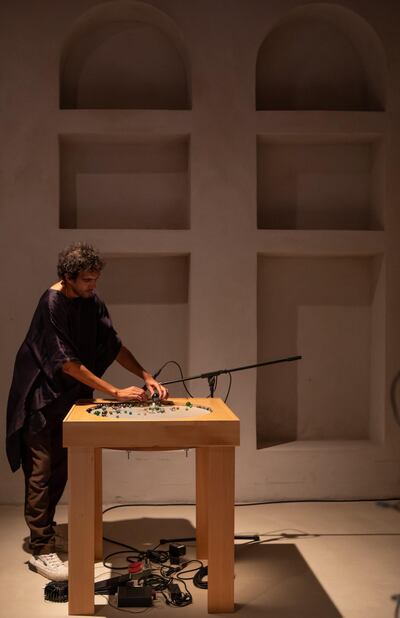
The show includes a number of instruments made by Atoui and his team. In one of the venue's hallways, the floor is strewn with small flat stones that have been fitted with rotary motors that strike at them with pebbles and chains, filling the room with bell-like chimes and metallic scraping. Another room in Bait Al Serkal features three cymbals, which are struck by motors fitted with lapidary tools for carving and polishing precious stones.
"With these instruments I wanted to show you the potential of the space," Atoui tells The National, after his performance. To him, each space is like a resonance case. Much like the hollow body of an acoustic guitar.
"The space is where the sounds are forming. The machines and sound devices are like the strings of the guitar," he says, gesturing to contraptions set up around him. "These works complete each other, echo and respond to one another. Like several orchestras playing together."
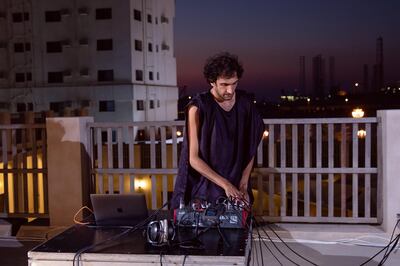
The instruments in Atoui's "orchestras" are not the kind you'd find in your local music store. There aren't any violins, cellos or pianos here. There is a flute-like instrument, but it is far from traditional in design or sound, instead played by a water-pump.
“Each instrument has its own story, it’s own adventure. Sometimes I come up with an idea and I share it with an instrument-maker or a craftsperson, and we work together on developing a few prototypes that lead us to the final idea,” Atoui says.
He also creates a manual for each instrument, whether in written or video form, to instruct others on how to operate the instruments, because he is less interested in fiddling with the sound devices himself.
"I have my way of doing things, but I'm very much curious and interested in how other people would do it," he says. "And that's actually what feeds the research and allows it to go further. So in a way, the idea of performing, improvising and working together becomes a part of the research process. The instruments can be used by several audiences from different cultures and that's what I like about this notion."
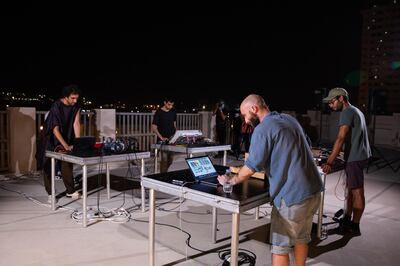
In his approach to making an instrument, Atoui seems set on emphasising the primordial quality of enjoying a sound, and his work expands on the definition of what a composition could be. There are no time signatures or scores. No melodies or rhythms, not in the traditional sense, anyway.
“The starting point is to consider sound as vibration and energy source,” he says. “This energy source is then translated by us to a cognitive message. But the body translates it to another type of message.”
He gives the example of his installation I/E, which features several custom-made instruments that play alongside recordings that Atoui took at Zayed and Khalifa ports with sound artist Eric La Casa in 2017. During Atoui's performance, the sounds I/E makes send vibrations to three metal girders on which a few audience members, myself included, are seated. As the installation's instruments make a series of hurried clicks and hisses, the rumbles expand in my chest and under my earlobes.
“The body is like a vector of reading sound. There are very intricate relationships between the notion of instrument, sound and body. The work is constantly navigating between these three aspects, combining them in a different way according to each piece.”
Atoui will now be leading a residency at the foundation, which aims to further explore these intricate relationships. Eleven artists from around the world will be working with him and his team to develop and operate sound devices and audio installations. The residencies will be running from mid-November until March, and will be mindful of social-distancing measures. Two residents will go to the space each month to work with a single resident adviser. There will be performances at the foundation taking place after the residency wraps up next year. – depending on the health and safety rules in place at the time.
“The residents will be working here, but we’ve also set up another space in an abandoned kindergarten in Kalba,” Atoui says. “Besides being a performing space and a social space, it will also be a workshop space, where the residents will be able to record sounds from the natural reserves of Sharjah, the historical sites as well as the mangroves nearby.”
Tarek Atoui's Cycles in 11 is on view at Sharjah Art Foundation until Saturday, April 10, 2021. More information is at www.sharjahart.org
